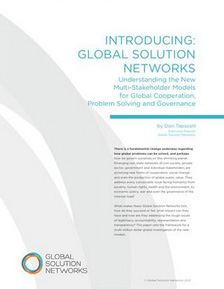The Federal Communications Commission’s National Broadband Strategy is an ambitious ten-year plan to bring the benefits of broadband to all citizens in the country. Just prior to the Strategy’s submission to Congress last week, FCC Chairman Julius Genachowski gave a speech entitled “Digital Opportunity: A Broadband Plan for Children and Families.” Unfortunately, the speech attracted zero media interest.
Genachowski announced a highly laudable “Children’s Agenda for Digital Opportunity.” It has four core pillars: digital access, digital literacy, digital citizenship, and digital safety.
Digital Access. Genachowski said the country should have a clear and non-negotiable goal: every child should be connected to broadband. Today this is not the case. More than 13 million school-age children don’t have broadband at home, and many have only limited access to broadband connections at school. The result: 25 percent of U.S. children – one out every four kids – are missing out on the opportunities of broadband.
FCC research shows that children in greatest need are those with parents who are poor, less educated, in rural America, or minorities. One study found that low-income children who use the Internet more at home had higher GPAs and standardized test scores than children who use it less. While 82 percent of white parents with children have broadband at home, that number plummets to 45 percent for Hispanic families.
A teenager with parents making less than $20,000 a year is less than half as likely to have broadband at home as a classmate whose parents make more than $75,000.
Digital Literacy. We have to make sure our children are digitally literate. “Digital literacy doesn’t just mean teaching children basic digital skills like getting online, using software and search – though it means that, and that’s important. It also means teaching kids to think analytically, critically and creatively, so that they can find relevant information, assess the accuracy and reliability of that information, distinguish fact from opinion, and create and share new content.”
We also have to teach our children to become media literate so that they can evaluate media content and recognize advertising for what it is. Both digital and media literacy skills are particularly critical given the average American child today spends more time with digital or analog media than they spend in school – or even sleeping.
Unfortunately, many children are not learning effective digital or media literacy skills at home or at school. In fact, many parents and teachers say that they don’t sufficiently understand digital technology, much less know how to teach kids about how use it effectively.
Digital Citizenship. Helping our children benefit from digital technology isn’t just about giving them access and teaching them to use tools effectively. We also have to teach them how to become responsible members of a larger digital community. Digital citizenship means the values, ethics, and social norms that allow virtual communities, including social networks, to function smoothly. It means having norms of behavior that facilitate constructive interaction and promote trust.
Unlike communities in the real world, digital communities face some unique challenges. People can remain anonymous or change identities, allowing them to act without regard to consequences. These challenges raise some hard questions for parents and policymakers. How do we create a framework of online norms and values? Who determines what these values and norms should be? How do we reinforce real-world values to our children, and teach them to behave in a positive and responsible manner online?
Digital Safety. One of the first things that jumps into parents’ minds when they think about their kids being online is safety. Understandably so. Forty-three percent of kids have been cyberbullied, but only 10 percent tell someone about it. Thirty-five percent of eating disorder patients visit pro-anorexia websites. A quarter of U.S. teens with cell phones say they have texted while driving. According to the National Highway Transportation Safety Board, 80 percent of fatal teen accidents are caused by distracted driving.
Genachowski outlined steps the FCC would take to boost digital youth literacy, including the establishment of a three-part National Digital Literacy Program:
- An Online Digital Literacy Portal will allow any child, parent, or teacher with a broadband connection to take courses on digital literacy.
- A Digital Literacy Corps will mobilize thousands of technically-trained youths and adults to train non-adopters, including families that are hard to reach because of cultural and language barriers.
- The FCC will push for libraries and other community centers to have more broadband capacity so that they can continue to help families become digitally literate.
It’s encouraging to see the FCC’s sense of urgency in addressing the broadband deficit. Currently the US ranks 19th in the world behind Japan, Korea and France-the leaders in a 2008 world ranking for broadband speed.






“FCC Chairman Julius Genachowski gave a speech entitled “Digital Opportunity: A Broadband Plan for Children and Families.” Unfortunately, the speech attracted zero media interest…. Digital literacy…means teaching kids to think analytically, critically and creatively, so that they can find relevant information, assess the accuracy and reliability of that information, distinguish fact from opinion, and create and share new content.””
I think this might be why this important speech didn't attract the press! Especially not Fox News. I'm afraid we both have to face it: the press doesn't want us to start evaluating them with regard to accuracy, quality, etc., since they fail to be neutral time and again. Perhaps this broadband plan will help, and maybe the kids, upon growing up, will be better media outlets.
Greetings, Don.
As an educator, I was thrilled to find your concise information on broadband in our schools. The technology is here, but how and if schools choose to implement is a different story. Throughout my masters program, I hear of fellow teachers whose district has “shut-down” broadband access for all due to one student’s erroneous behavior. WE need to be ahead of technology, not behind it. Broadband access to all students provided by “education” knowledgeable IT/MIS staff is the first step. For many schools where broadband is offered, the stringent firewalls prove to be counterproductive and cumbersome. We need IT/MIS provided by professionals who understand the educational classroom. All 21st century schools should be advocates in teaching digital literacy, digital citizenship, and digital safety. At this point in the game, digital access should not even be a question; it should have already become an answer: yes, to broadband in all schools.
Cheers,
Natalie